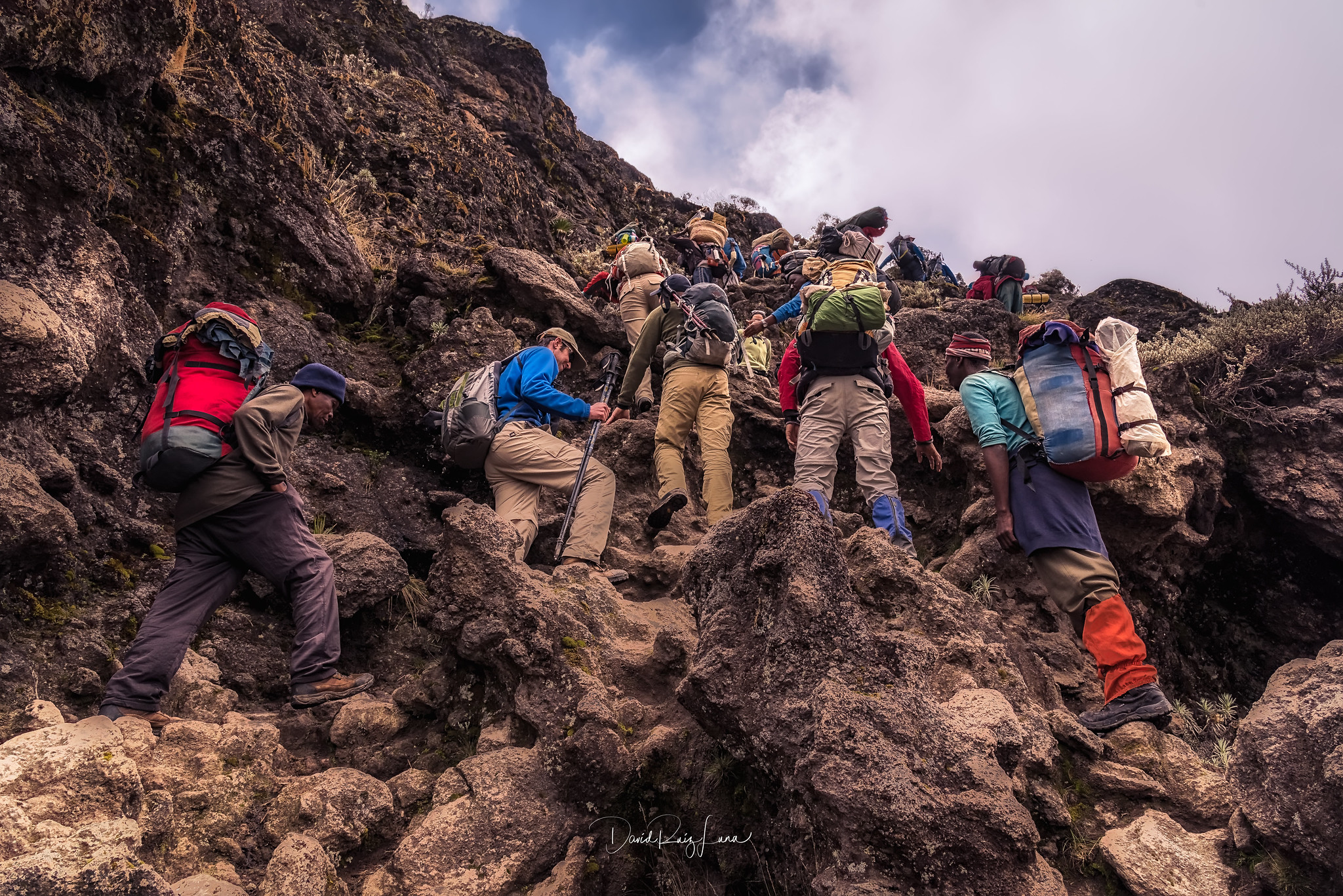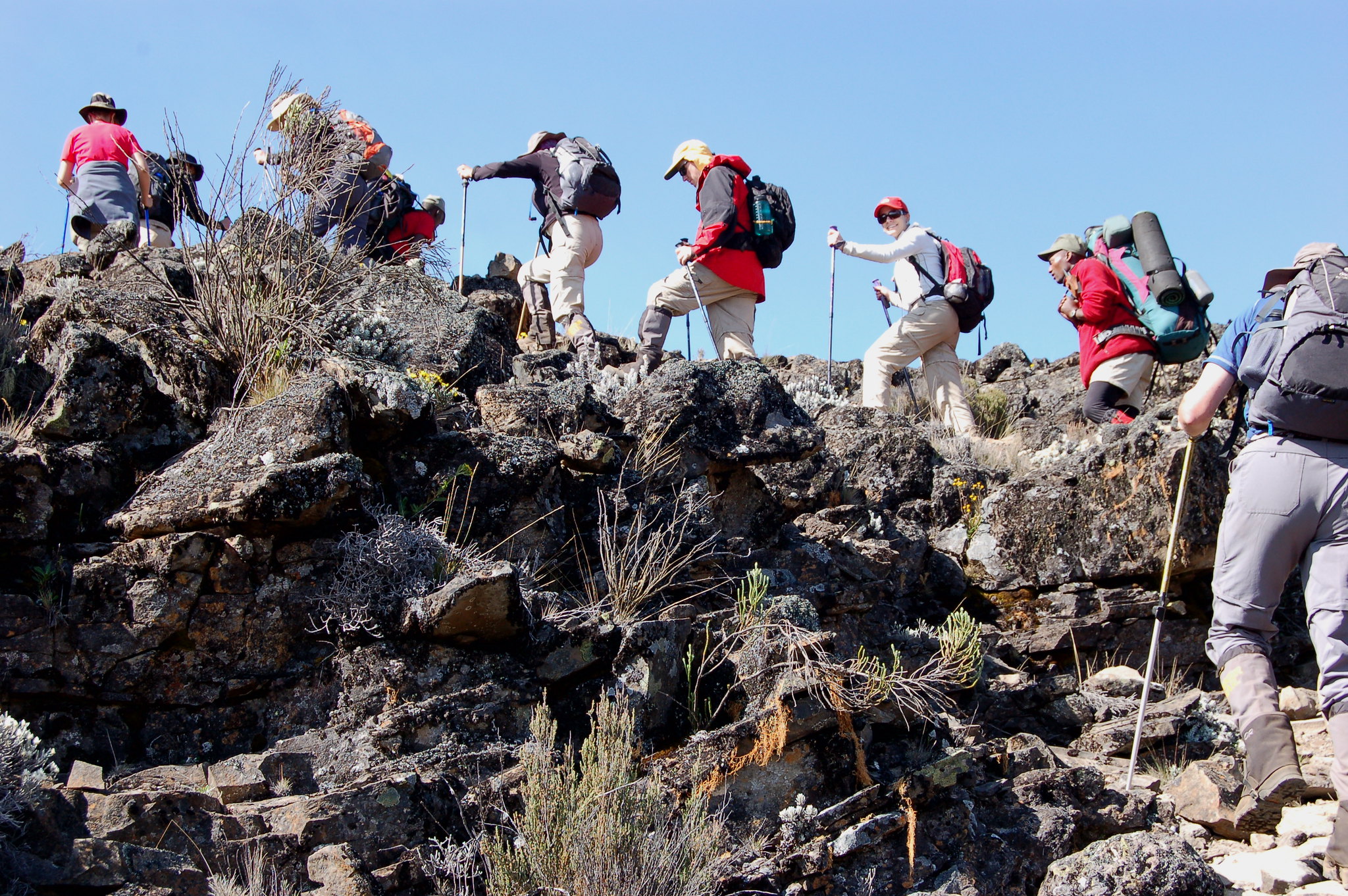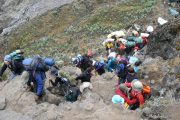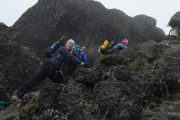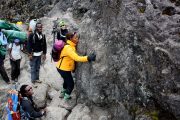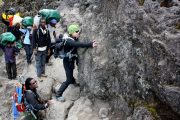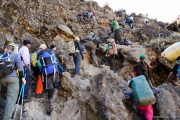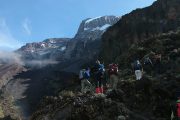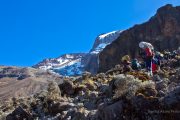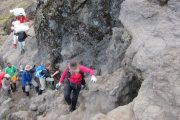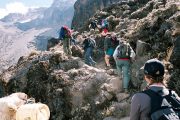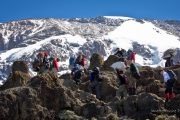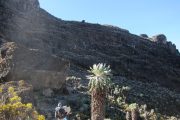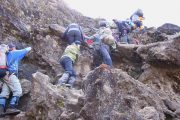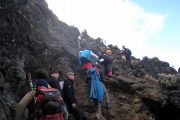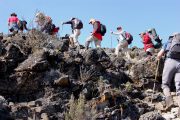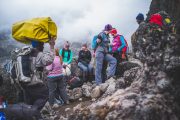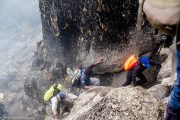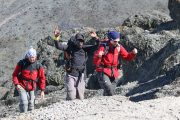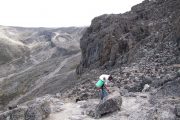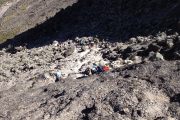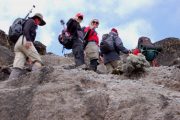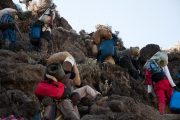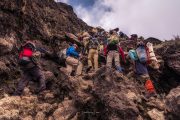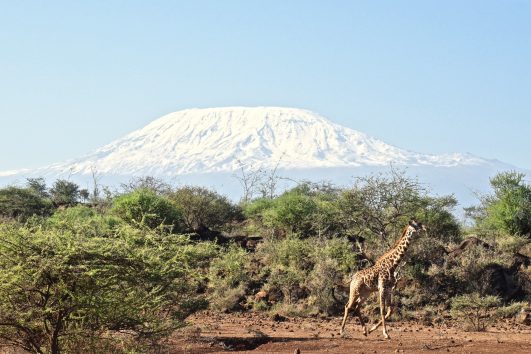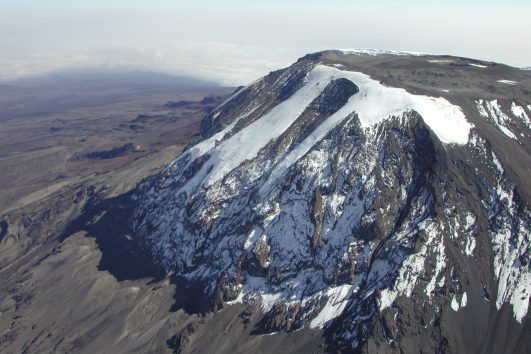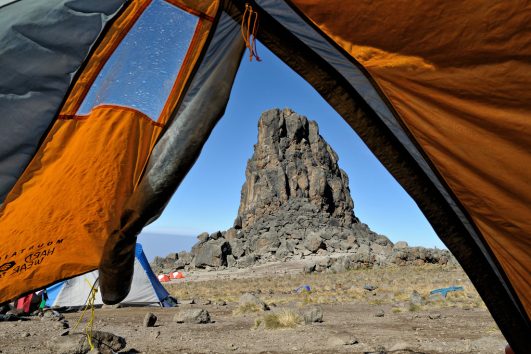Barranco Wall Elevation / Altitude: 3950 meters
The Barranco wall is a ridge standing at 843 feet (257 meters) above the Barranco Valley that was formed after a past volcanic activity that also formed the Kibo Crater at the summit of Mount Kilimanjaro.
This wall was formed when molten lava flowing from Kibo cooled on its own slopes. After constant and repeated weathering plus erosion, the ridge started to shape up.
The Barranco wall slope in height comparison comes second to only that of the final ascent to Kibo or Mawenzi, which form the three peaks of Mount Kilimanjaro on the summit day.
How to climb the Barranco Wall
Climbing the Barranco Wall is an exciting adventure that involves hiking on rock formations, grabbing onto ledges, and pulling yourselves up, looking for the next place to put a foot or a hand, more like rock climbing. The steepness of the Barranco Wall can be a challenge for some climbers. The video below shows how mountain trekkers are climbing the Barranco Wall on Mount Kilimanjaro.
Location of Barranco Wall
The Barranco wall is located on the Southern side of Kibo’s foot slopes along the Machame, Umbwe and Lemosho Routes. Only a stone’s throw away from the Barranco campsite.
Tips for how to climb the Barranco Wall
Below are the most important tips for climbing the Barranco Wall on Mount Kilimanjaro
- Don’t rush or attempt to exhaust yourself excessively. The greatest strategy is to go slowly and steadily, or “pole-pole,” as they say in Swahili.
- Pay attention to your guide. Your experienced Tranquil Kilimanjaro guide has scaled Barranco Wall several times and can offer guidance on balance, when it’s best to place a hand on a rock, and other matters.
- Do not use your trekking poles; instead, secure them to your pack so that you may use your hands as necessary.
- Do not be anxious about this climb; although it appears to be much more difficult from a distance, many climbers say that it was one of the most enjoyable experiences of their whole Kilimanjaro ascent.
- The climb could feel ‘packed’ during busier times as you wait for a team in front to negotiate a tight passage. Maintaining positive attitudes when climbing Barranco Wall is important for both you and the other climbers.
- Using your hands, knees, and even your head to climb a steep slope is known as “scrambling.” There are even several levels of scrambling, although Barranco Wall is a low-level activity that doesn’t call for any specialized gear or safety precautions.
- Spend some time admiring the scenery; the panoramas all along Barranco Wall are breathtaking!
- Be proud of yourself for completing this task successfully. When you reach the top, take a picture of yourself (or your squad, or perhaps a few new acquaintances).
How hard is it to climb the Barranco Wall?
Climbing the Barranco Wall could be one of the hardest bits of trekking the mountain but despite the Barranco Wall being one of the most dreaded and feared parts of climbing the mountain, everyone is always skeptical about it. Is it just a fun boulder scramble or a scary journey up a towering rock face, clutching to the cliff with fingers and toes to prevent falling to death in the void below?
The Barranco Wall is the most feared part of Mount Kilimanjaro’s Lemosho Route
it is not as hard as you may think, this wall doesn’t require you to have any technical climbing skills or equipment to get up it.
Which routes take you to the Barranco Wall?
Mountain climbers using the Shira, Lemosho, Umbwe, and Machame routes encounter these rocky slopes of the Barranco Wall when going up the mountain.
To climb the Barranco Wall, you do not need any special technical skills as the climbing trail leads you through a winding path with the least slope and highest safety.
It might take you approximately 1-2 hours to climb the Barranco Wall depending on the level of your fitness.
Climbers normally use the Barranco wall as an acclimatization trek, as it takes you to the Karanga Huts campsite, which is the next campsite you encounter after taking a descent.
Which Routes do not take you to climb the Barranco Wall?
The Northern Circuit, Marangu, or Rongai Routes are your best options if you do not want to climb the Barranco Wall at all.
While Tranquil Kilimanjaro highly recommends the Northern Circuit and Rongai, one of the popular routes is the Marangu Route.
When do you climb the Barranco Wall?
Mostly, you are likely to climb the Barranco Wall on the third or fourth day depending on the route that you choose whether it is the Machame, Umbwe, or Lemosho routes, and the number of days you will spend on the mountain.
Best time to climb the Barranco Wall
Since the Lemosho, Machame, and Umbwe routes include the Barranco Wall in their respective itineraries we recommend the best time for climbing the Barranco Wall to be during the dry seasons (late December to early March and early June to late September).
If you intend to climb Kilimanjaro in April, May, October, or November, take into account the Marangu or Rongai routes which are favourable routes for the wet seasons.
Barranco Wall Vegetation Zone & Weather
It lies at the border between Mount Kilimanjaro’s alpine desert and the moorland vegetation regions, the presence of a few plants growing at the foot and on the wall of the Barranco Wall.
Fogs are a common occurrence in the early mornings. Barranco Wall area also receives a small amount of rainfall or sleet, making the climb a little challenging, especially in the mornings.
How high is the Barranco Wall?
Barranco Wall is 257 meters (or 843 feet) high and rises from the Barranco Valley on Mount Kilimanjaro. Unlike some parts of the mountain where climbers hike normally on two feet, the Barranco Wall is special as it demands climbers to use their hands as well as their legs to climb up the Barranco Wall. It also requires much care and attention when navigating up large boulders or rocks on Barranco Wall.
The only part of the Barranco Wall that would demand you to be more careful to avoid falling is the Kissing Rock part also known as the hugging wall.
Barranco’s Kissing Rock or Hugging Wall
There is a part of climbing the Barranco Wall, popularly known as the Kissing Rock or the hugging wall at the top of the Barranco wall where the path becomes narrower and the only option you have is to hold onto it like you have to literally hug it so close to your face like you are almost kissing it to be able to navigate safely. It is the most dreaded part of climbing the Barranco Wall as it requires some tricks to navigate past this part of the wall. If you follow the correct guidelines from our guides, then there is nothing to worry about and it is not as scary as you might think.
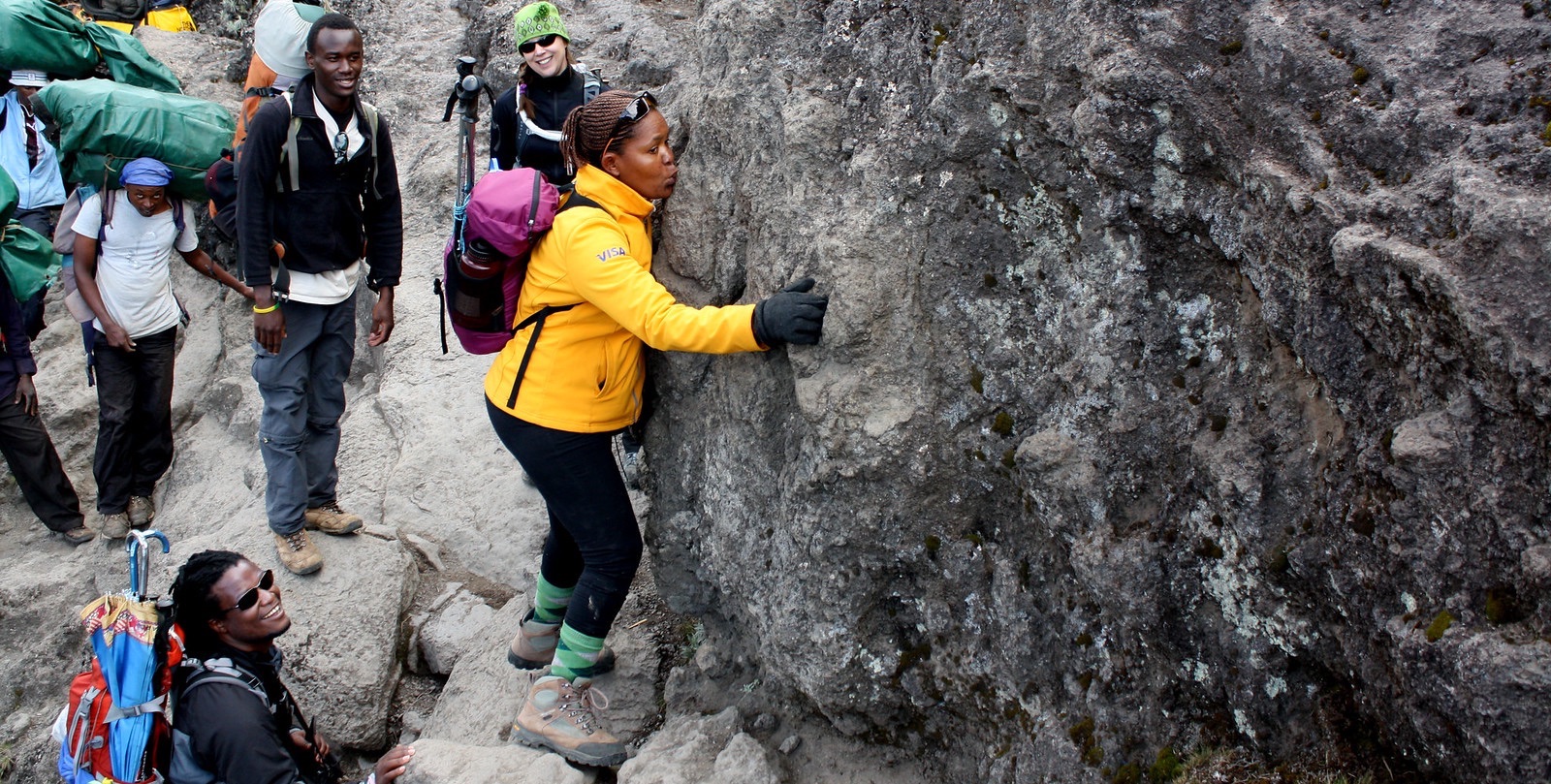
Is the Barranco Wall dangerous?
If it were a really risky operation, another route should be chosen to avoid “such a terrible endeavour,” since there are alternative ways to reach the Kilimanjaro Summit that do not pass the Barranco Wall. Currently, for many climbers of Kilimanjaro, the Barranco Wall ranks right up there with the summit as one of the highlights of the ascent.
Barranco Wall is not very dangerous overall. There are, however, certain stretches of the ascent where caution is advised. We advise climbers to move gently, taking their time to set their feet and establish their balance rather than pushing themselves to the summit.
Can you die while climbing Kilimanjaro’s Barranco Wall?
The main cause of death on Mount Kilimanjaro happens as a result of altitude sickness (AMS) not falling off the Baranco Wall. If you follow the guide’s advice and guidelines, you should be just fine. Remember, climbing Kilimanjaro is not a 100-meter dash, it is more of a marathon, meant to test your endurance thus you should take it slowly.
HOW LONG DOES IT TAKE TO CLIMB THE BARRANCO WALL?
It will take roughly 2 hours to navigate the Barranco Wall and get to the top where you will be rewarded by stunning views of Kibo, the mountain’s main peak gaining a total of 300m of altitude.
What makes the Barranco Wall so unique?
This section of the route is distinctive in that several climbing teams congregate here and ascend Barranco Wall simultaneously. Often, when a team faces Barranco Wall together, a sense of togetherness develops, and climbers may discover total strangers yelling support or their team unites in a unique way. Occasionally, teams may take a massive multi-group picture to remember the new friends they met while scaling Barranco Wall.
Choose an alternate ascent path up Kilimanjaro if Barranco Wall’s outlook makes you nervous. You don’t have to abandon your goal of climbing Kilimanjaro because of the Barranco Wall.
Additional information
| Vegetation | The border between alpine desert & moorland vegetation |
|---|

